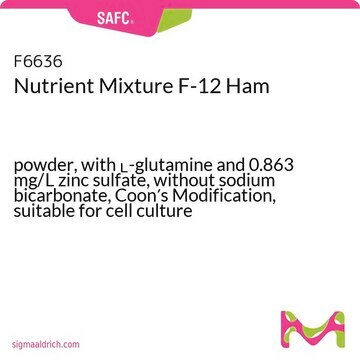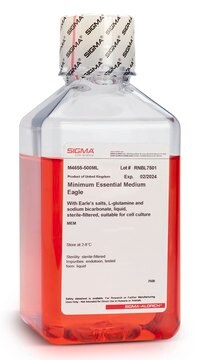N3520
Nutrient Mixture F-12 Ham
Kaighn′s Modification, with L-glutamine, without sodium bicarbonate, powder, suitable for cell culture
Synonym(s):
Ham’s F-12
Sign Into View Organizational & Contract Pricing
All Photos(1)
About This Item
Recommended Products
form
powder
technique(s)
cell culture | mammalian: suitable
components
NaHCO3: no
sodium pyruvate: 0.22 g/L
HEPES: no
L-glutamine: yes
phenol red: yes
shipped in
ambient
storage temp.
2-8°C
Looking for similar products? Visit Product Comparison Guide
General description
The nutrient mixture Ham′s F-12 is developed by Ham and it has higher levels of amino acids, vitamins and trace elements. Putrescine and linoleic acid are added to the formulation. Nutrient medium was originally designed for the serum-free growth of Chinese hamster ovary and lung cells. When used with whole or dialyzed serum or in combination with hormones and transferrin, it is widely used to grow mammalian and hybridoma cells.
Application
Nutrient Mixture F-12 Ham is used for the following applications:
Kaighn′s modification of Ham′s F-12 and Coon′s F-12 has increased concentrations of amino acids and pyruvate, as well as modified salts (Konigsbergs). This medium was designed to support the growth of differentiated rat and chicken cells, and primary human liver cells.
- HeLa (human cervix adenocarcinoma cells) were grown in this medium (nutrient mixture F-12 Ham) supplemented with 10% heat-inactivated fetal calf serum
- Used in cell culture for different cells during maintenance and incubation (i.e. A549 cell line was maintained as a monolayer in nutrient mixture F-12 HAM Medium along with other components)
- Used in media for the propagation of Cowdria ruminantium
- Used during preparation of primary mixed glial cultures
Kaighn′s modification of Ham′s F-12 and Coon′s F-12 has increased concentrations of amino acids and pyruvate, as well as modified salts (Konigsbergs). This medium was designed to support the growth of differentiated rat and chicken cells, and primary human liver cells.
Quantity
Formulated to contain 11.1 grams of powder per liter of medium.
Reconstitution
Supplement with 2.5 g/L sodium bicarbonate.
also commonly purchased with this product
Product No.
Description
Pricing
Signal Word
Warning
Hazard Statements
Precautionary Statements
Hazard Classifications
Skin Sens. 1
Storage Class Code
11 - Combustible Solids
WGK
WGK 3
Flash Point(F)
Not applicable
Flash Point(C)
Not applicable
Choose from one of the most recent versions:
Certificates of Analysis (COA)
Lot/Batch Number
Don't see the Right Version?
If you require a particular version, you can look up a specific certificate by the Lot or Batch number.
Already Own This Product?
Find documentation for the products that you have recently purchased in the Document Library.
Customers Also Viewed
Yue Wu et al.
Frontiers in genetics, 12, 574196-574196 (2021-07-10)
Post-transcriptional regulation plays a leading role in gene regulation and RNA binding proteins (RBPs) are the most important posttranscriptional regulatory protein. RBPs had been found to be abnormally expressed in a variety of tumors and is closely related to its
Chia-Herng Yue et al.
Biomolecules, 11(6) (2021-07-03)
Medullary thyroid cancer (MTC) is a neuroendocrine tumor that arises from the parafollicular C-cells, which produces the hormone calcitonin. RET is a transmembrane receptor protein-tyrosine kinase, which is highly expressed in MTC. Our previous studies reported that cyclin-dependent kinase 5
Xudong Huang et al.
Journal of biological inorganic chemistry : JBIC : a publication of the Society of Biological Inorganic Chemistry, 9(8), 954-960 (2004-12-04)
Nucleation-dependent protein aggregation ("seeding") and amyloid fibril-free formation of soluble SDS-resistant oligomers ("oligomerization") by hydrophobic interaction is an in vitro model thought to propagate beta-amyloid (Abeta) deposition, accumulation, and incur neurotoxicity and synaptotoxicity in Alzheimer's disease (AD), and other amyloid-associated
Jose A P Diniz et al.
The American journal of tropical medicine and hygiene, 75(4), 691-696 (2006-10-14)
Primary cultures of embryonic murine neurons and newborn mouse astrocytes were inoculated with West Nile virus (WNV) strain NY385-99 to compare the pathogenesis of WNV infection in these types of CNS cells. Two different outcomes were observed. WNV infection in
Hong Yang et al.
Environmental science and pollution research international, 25(1), 867-876 (2017-10-27)
This research is designed to investigate the regulatory effect of miR-18a to the target gene connective tissue growth factor (CTGF, or CCN2), by participating in TGF-β1 signaling pathway and explore the pathogenic mechanism of miR-18a in pulmonary injury induced by
Our team of scientists has experience in all areas of research including Life Science, Material Science, Chemical Synthesis, Chromatography, Analytical and many others.
Contact Technical Service








